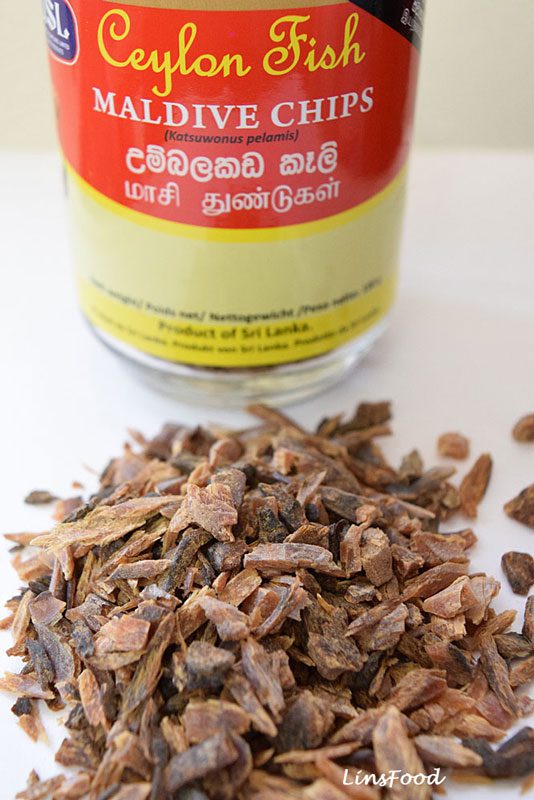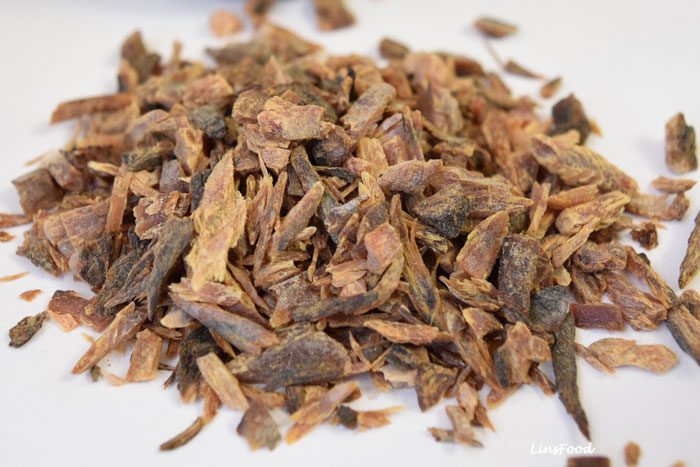Estimated reading time: 2 minutes
Maldive fish is the Sri Lankan equivalent of South East Asia’s dried shrimp, dried anchovies and shrimp paste and the Japanese Katsuobushi. It has a concentrated aroma and flavour of the sea, much like dried shrimp but leaning more towards that of fish. Like dried shrimp, maldive fish chips are jam packed with umami flavour, a little goes a long way.

Maldive fish is essentially dried and cured fish, usually tuna, the jar above says katsuwonus pelamis, which is skipjack tuna. It is used in very small amounts in Sri Lankan and Maldivian cooking and also in certain cuisines of the very south of India.
It’s not only used as a flavour enhancer but also as a thickening agent and in poorer parts, even as the protein in the family meal. Many of Sri Lanka’s famous dishes have Maldive fish in it, like the Sri Lankan Coconut Sambal, Pol Sambal.
As you can see in the picture, it is sold in little pieces that resemble tiny wood chips. One of my favourite ways of using it is definitely when I make sambal and fish dishes, whether of Sri Lankan origin or not.
What to substitute Maldive Fish with?
As mentioned above, Maldive fish has strong flavour and aromatic similarities to dried shrimp and anchovies. However, I personally think that dried shrimp and most certainly, shrimp paste, are the wrong ingredient to substitute it with. You are better off using katsuobushi or dried anchovies if you can get them but an easier and very effective substitute is simply canned anchovies in oil. Drain and wipe dry the anchovies, pound them and use right at the end of cooking to preserve as much of the flavour as possible.


Many years in Sri Lanka, mostly in the villages, we use to fry the anchovies/dry fish in oil till crisp, and serve on the side with curries, then add a pinch to each bit. It adds a little crunch to each bit and the flavor is wonderful.
Thank you for sharing that with me, Jerry. I have a few dried anchovy recipes on my other blog.
Do you just add as is or do you soak to rehydrate first? I’ve added to seeni sambol while cooking the onions and you definitely feel the chunks of maldive fish when you eat it. I’m wondering if that’s right.
Hey Al, I’ll have to update this old article to include information on how to use it.
Maldive fish needs to be pounded to little bits before being used. As we usually only need a little of it at a time, this is easily done with a pestle and mortar.
These days though, you may be able to buy the stuff pre crushed or in powdered form.
I hope that helps.
I am allergic to fish but would like to make some Sri Lankan dishes that call for it. Is there anything else I can use or can I just leave it out? Please help.
Hi Gail, I would just leave it out. I think the flavour is too unique to bother to try and find a substitute for, if you are allergic to fish. Some things just don’t have any substitutes, like galangal and curry leaves.